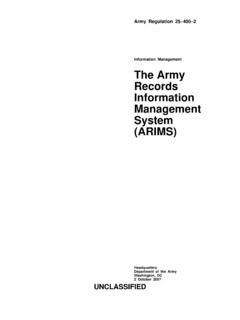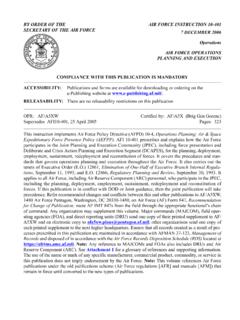Transcription of Chapter 1: WHAT IS CHANGE MANAGEMENT? What Is …
1 Chapter 1: what IS CHANGE management ? 1. Title: what Is CHANGE management ? 2. Author: Jin-Hyuk Ahn, Sathappan Thiagarajan, and Subramaniam Ramasubramanian, Aleesha Hegde, Josiah Johnson, Vivek Venkatramani 4. Chapter Objectives: Key concepts of this Chapter are;. Definition of CHANGE management The Importance of Collaborative and Interactive Relationship for CHANGE management Paradigm Shift in Business Strategic Programs to CHANGE management Emotional Factors and People Issues for CHANGE management Eight Steps of CHANGE Process Ten Principles of CHANGE management We will also explore two case studies relating to the need for CHANGE management 5. Introduction: This book is part of The Global Text Project1 which is a project which will create open content electronic textbooks that will be freely available from a website. The goal is to make textbooks available to the many who cannot afford them. The main vision behind developing this project is not to have just simple transfer of knowledge but to engage those who used these books to engage actively in improving the quality this book.
2 The CHANGE management book was written by students studying in the Day Master of Science in Information management (MSIM). program at the Information School, University of Washington under the guidance of Mr. Kevin Clyde D'Souza and consultants and executives working at BearingPoint. In this Chapter , you will learn a general definition of CHANGE management . Also, you will find out the reason why lots of modern enterprises try to adopt CHANGE management to their businesses through analyzing well-known management innovation programs such as ERP, 6- Sigma, etc. The purpose of this Chapter is not only to give general concepts of CHANGE management , but also introduce the eight steps of CHANGE Process and the ten principles of CHANGE management . 6. Chapter Content: A. W. Whhaatt iiss C. Chhaannggee M. Maannaaggeem meenntt?? 1. 1. Definition of CHANGE management Any modern enterprise having a fear to CHANGE never survives today!'. Society today is characterized by ongoing quick CHANGE .
3 Given the speed at which business moves the market, many enterprises are out of breath and struggle to simply keep up. This means that today, successful business is based on the management capacity to oversee and adapt to fast forward CHANGE . Thus, fast, reliable, active, and comprehensive countermeasures to overcome an accumulated stereotyped idea and a traditional organizational culture in the current business environment is the key for survival. Meanwhile, there has been a new tool for the business operation called CHANGE management .' what is CHANGE management ? CHANGE management is a systematic activity to prepare an organization for and implement ongoing environmental changes in a business operation. So to speak, CHANGE management is about innovative strategies and speedy activities to deal with variable and sudden changes. In addition, the current definition of CHANGE management can contain individual CHANGE management models to address the people side of Generally, CHANGE management can address the large part of a business operation from planning to controlling; organization and governance structure, product development, customer satisfaction etc.
4 Successful CHANGE management not only improves the governance structure which needs to be changed, but also raises productivity up to the maximum level by modifying and complementing the existing organization system. Through these processes, the customer satisfaction can be done with a good image and benefit of a business enterprise. To achieve the most optimal result via CHANGE management , it is critical that each organization member works collaboratively and maximizes their capacity. From the management -level to entry-level employees, they should make one voice based on the business vision and goals. However, there are always various types of people in the organization for the matter of CHANGE ; passive, active, stubborn, or apathetic. Because of these diversities, a leader has to lead his/her members to one direction. In this way, the role of the CHANGE manager' is important to control the variable inside of its organization. In addition, the role of the sponsor and active support that CHANGE needs to receive from the sponsor should take into the consideration for more effective CHANGE management .
5 No 2. Original description for CHANGE management from Wikipedia, available at (people). matter how good a leader we have, CHANGE is likely not to succeed without strong sponsorship and partnership. According to the report result from , they suggested as follows; active and visible executive sponsorship is the number one contributor to CHANGE management success.'3 Through this collaborative and interactive relationship between two or more, each organization can not only exchange the ideas for changes, but also conduct its business for mutual benefit. Also, an information technology and engineering aspect of CHANGE management takes into the consideration a systematic approach which keeps tracking the system in the organization. For example, what kind of operation system will be reliable to each individual's computer, how often the system update will be made by user's feedback and bug reports, and what patches have to be updated for the system resilience?
6 To decrease the potential risk by changing the system, IT engineers should construct communication, education, and feedback systems which can be changed or updated by the internal and external needs of the targets of CHANGE . These needs (data, contents, system requirement, etc.) enable the IT engineers to estimate the potential risk for the CHANGE , the detailed system implementation steps to minimize the risk, and the budget control for system implementation. 2. Paradigm Shift to CHANGE management management Innovation program focuses on the client-centered business operation'. Before going to next phase, it is worthy of taking a look at the real and simple business cases which could make it for companies have competitive business resilience under the fast changing business environment. Through these cases, CHANGE management is not only applicable to the organizational structure, but also reliable to in and outside factors of the organization such as maintaining a competitive business strategy and developing a nice product.
7 3. available at There are several management Innovation programs to deal with CHANGE for any modern company, such as 6-Sigma, TQM (Total Quality management ), TPM (Total Productive Maintenance), ERP (Enterprise Resource Planning), etc. Especially among these, 6-Sigma and ERP are the most figurative and energetic programs on the basis of an innovative quality in an electronic and manufacturing field most actively. 6-Sigma is a management philosophy and methodology which was invented by Motorola. It focuses on producing reliable and consistent results through minimizing process variation. As of today, various sectors of industry implement 6-Sigma to the large part of the applications in many different ways. And the main purpose of using 6-Sigma is to discover and then eliminate the causes of defects or errors in manufacturing lines and business More detailed 6-Sigma procedure is described below: Originally, it referred to the ability of manufacturing processes to produce a very high proportion of output within specification.
8 Processes that operate with "six sigma quality". over the short term are assumed to produce long-term defect levels below defects per million opportunities (DPMO). Six Sigma's implicit goal is to improve all processes to that level of quality or better.'5 Six Sigma, Wikipedia For a decade, most of the world's leading companies (Citibank, GE, POSCO, Samsung, etc.) imported 6-Sigma program to their businesses in order to increase the product quality and achieve cost savings. As a striking example, GE produced the key concepts for its 6-Sigma implementation as follows;6. Critical to Quality: Attributes most important to the customer Defect: Failing to deliver what the customer wants Process Capability: what your process can deliver 4. Jiju Antony. "Pros and cons of Six Sigma: an academic perspective". Retrieved on 1 May, 2008. 5. Six Sigma, Wikipedia, available at 6. Jack Welch, Winning, Chapter 15: Six sigma, Collins Business; 1 edition (April 5, 2005). Variation: what the customer sees and feels Stable Operations: Ensuring consistent, predictable processes to improve what the customer sees and feels Design for 6-Sigma: Designing to meet customer needs and process capability Generally, these management innovation programs have a goal of Customer Satisfaction.
9 ' It is very important for the customer management to treat each customer as its family members. Maintaining the product quality is also critical. Thus, these kinds of programs and projects, which aim to improve the system and product development of a company, can be most reliable when they can measure the customer [clients] needs accurately. In addition, here is another management Innovation Program which can be successfully implemented to the target organization by CHANGE management ; Enterprise Resource Planning (ERP). From this case, you can recognize the importance of CHANGE management . For the successful ERP implementation, analyzing the reason why system implementation failed is more important than evaluating the system itself. Usually, the enterprise using ERP starts analyzing the reason of failure from the internal system. But in most of the cases, external factors tend to be more critical to make their ERP systems fail such as choice of a consulting firm and an internal The choice of a consulting firm is as important as the student needs to have a brilliant teacher for better education.
10 Here is a critical comment about this: There is much hype when the vendors are out to move their products, and will always sell and tell you about their success stories and how you will leapfrog into your vision. They never tell you of any failures of such ERP projects, and there seems to be no attention paid to lessons learnt from the famous FoxMeyer Corporation scenario, which lead to its bankruptcy and the lengthy legal battles in the courtrooms with their consultants thereafter. My basic principle is that you don't make decisions because they 7. A Recipe and Ingredients for ERP Failure, available at are easy, you don't make them because they are cheap, you don't make them because they are popular but you make them because they are right.' - Theordore Hesburgh . Ernest Madara, In addition, the internal support is usually more complex than choosing a reliable consulting firm. The internal support consists of several processes such as budgetary allocation, mobilization of man-power, CHANGE management , etc.







